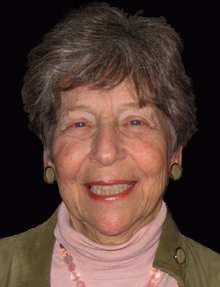Margaret G. Kivelson
Margaret Kivelson | |
|---|---|
 Kivelson in 2007 | |
| Born | Margaret Galland Kivelson October 21, 1928 |
| Nationality | American |
| Alma mater | Radcliffe College (A.B.), Radcliffe College (A.M.), Harvard University (Ph.D.) |
| Awards |
|
| Scientific career | |
| Fields | UCLA (1967-present) University of Michigan (2010-present) |
| Thesis | Bremsstrahlung of High Energy Electrons (1957) |
| Doctoral advisor | Julian Schwinger[1][2] |
Margaret Galland Kivelson (born October 21, 1928) is an American
Recent research has also focused on Jupiter's
Early life and education
Kivelson was born in New York City on October 21, 1928. Her father was a medical doctor and her mother had an undergraduate degree in physics.
Career
Kivelson completed her PhD thesis "
From 1955 to 1971 Kivelson worked as a consultant in physics at the
Motivated by her experiences in academia through the Radcliffe Institute, Kivelson joined
Scientific contributions
Kivelson has had a very successful career as a scientist that include many publications and original work.[1] Some of her accomplishments are discovering an internal magnetic field at Ganymede,[6] providing compelling evidence for a sub-surface ocean at Europa,[7] and elucidating some of the processes explaining the behavior of ultralow frequency waves in the terrestrial magnetosphere,[8] the discovery of cavity mode oscillations in the magnetosphere,[9] developed new ways of describing wave-particle interactions in magnetohydrodynamic waves,[10] and provided insight into the mechanism of interchange diffusion in rotating plasmas.[11] This research has led Kivelson to being an author or co-author on over 350 publications that have accumulated over 12,000 citations.[12]
Gender gap
Some of Kivelson's recollections about establishing a career as a woman scientist have been documented in an interview by the American Astronomical Society and piece in the Annual Review of Earth and Planetary Sciences. When she started to pursue her undergraduate degree in physics her family joked she was really pursuing a "Mrs" degree. Before World War II, courses at Radcliffe were segregated by gender from courses at Harvard. When she attended Radcliffe/Harvard in the first class after the war, classes did not return to being segregated. She was often the only woman in her courses.[2]
Over the course of
In 1973, Kivelson won a
Honors and awards
- Guggenheim Fellowship (1973–74)[3]
- Radcliffe Graduate Society Medal (1983)[14]
- Harvard University's 350th Anniversary Alumni Medal (1986)[4]
- Fellow of the American Association for the Advancement of Science (1989) [15]
- Fellow of the American Geophysical Union (1992)[16]
- NASA Group Achievement Award (1995, 1996)[14]
- Member of the National Academy of Sciences (1999)[3]
- Member of the American Academy of Arts and Sciences (1998)[3]
- Fellow of the American Physical Society (2001) [17]
- Fleming Medal of the American Geophysical Union (2005)[18]
- Alfven Medal of the European Geophysical Union (2005)[14]
- Elected member of the American Philosophical Society (2005)[19]
- Gerard P. Kuiper Prize of the American Astronomical Society (2017)[20]
- Jean Dominique Cassini Medal of the European Geosciences Union (2019)[21]
- Gold Medal of the Royal Astronomical Society (2019)[22]
- Elected Foreign Member of the Royal Society (2020) [23]
- James Clerk Maxwell Prize for Plasma Physics of the American Physical Society (2021) [24][25]
See also
References
- ^ a b c "How Do You Find an Alien Ocean? Margaret Kivelson Figured It Out". New York Times. October 8, 2018. Retrieved October 8, 2018.
- ^ .
- ^ a b c d e "Contributions of 20th Century Women to Physics". Archived from the original on 2013-08-06. Retrieved 2013-09-04.
- ^ ISBN 9781438118826.
- .
- S2CID 4246607.
- PMID 10958778.
- ISSN 0148-0227.
- S2CID 56251553.
- S2CID 55008683.
- ISSN 2156-2202.
- ^ "Margaret G. Kivelson". Thomson Reuters Citation Index. Retrieved 2013-09-04.
- ^ "AAS Committee on the Status of Women: Interview with Margaret Kivelson". Archived from the original on 2016-03-04. Retrieved 2014-04-08.
- ^ a b c "CLaSP mkivelso – Climate and Space Sciences and Engineering at the University of Michigan, College of Engineering". clasp.engin.umich.edu. Archived from the original on 2016-04-27. Retrieved 2016-04-06.
- ^ "1989 AAAS Fellow". Retrieved 2014-04-10.[permanent dead link]
- . Retrieved 2014-04-10.
- ^ "APS Fellow Archive". APS. Retrieved 18 September 2020.
- ^ "2005 John Adam Fleming Medal Winner". Retrieved 2013-09-04.
- ^ "APS Member History". search.amphilsoc.org. Retrieved 2021-06-08.
- ^ "2017 Prize Recipients - Division for Planetary Sciences". dps.aas.org.
- ^ "EGU announces 2019 awards and medals". European Geosciences Union (EGU).
- ^ "Leading astronomers and geophysicists honoured by Royal Astronomical Society | The Royal Astronomical Society". ras.ac.uk.
- ^ "Margaret Kivelson". Royal Society. Retrieved 19 September 2020.
- ^ "2020 APS Fall Prize & Award Recipients". www.aps.org. Retrieved 2020-07-24.
- ^ "2020 James Clerk Maxwell Prize for Plasma Physics Recipient". American Physical Society. Retrieved 2020-07-24.
